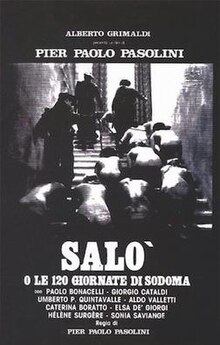Salò, or the 120 Days of Sodom
| Salò, or the 120 Days of Sodom | |
|---|---|

Original Italian release poster
|
|
| Directed by | Pier Paolo Pasolini |
| Produced by | Alberto Grimaldi |
| Screenplay by |
|
| Based on |
The 120 Days of Sodom by Marquis de Sade |
| Starring |
|
| Music by | Ennio Morricone |
| Cinematography | Tonino Delli Colli |
| Edited by | Nino Baragli |
|
Production
company |
Produzioni Europee Associati
Les Productions Artistes Associés |
| Distributed by | United Artists |
|
Release date
|
|
|
Running time
|
116 minutes |
| Country |
|
| Language | Italian French German |
| Box office | SEK 1,786,578 |
Salò, or the 120 Days of Sodom (Italian: Salò o le 120 giornate di Sodoma), titled Pasolini's 120 Days of Sodom on English-language prints and commonly referred to as simply Salò (Italian: [saˈlɔ]), is a 1975 Italian-French horror art film directed by Pier Paolo Pasolini. It is based on the book The 120 Days of Sodom by the Marquis de Sade. The film focuses on four wealthy, corrupt Italian libertines, during the time of the fascist Republic of Salò (1943-1945). The libertines kidnap eighteen teenagers and subject them to four months of extreme violence, sadism, and sexual and mental torture. The film explores the themes of political corruption, abuse of power, sadism, perversion, sexuality and fascism. The story is in four segments, inspired by Dante's Divine Comedy: the Anteinferno, the Circle of Manias, the Circle of Shit and the Circle of Blood. The film also contains frequent references to and several discussions of Friedrich Nietzsche's 1887 book On the Genealogy of Morality, Ezra Pound's poem The Cantos, and Marcel Proust's novel sequence In Search of Lost Time.
It was Pasolini's last film; he was murdered shortly before Salò was released. Because it depicts youths subjected to intensely graphic violence, relentless sadism, sexual deviance, and brutal murder, the film was extremely controversial upon its release, and remains banned in several countries. For instance, it was only in the year 2000 that it was granted an uncut release in the UK. It has been praised by various film historians and critics and was named the 65th scariest film ever made by the Chicago Film Critics Association in 2006 and is the subject of an article in The Penguin Encyclopedia of Horror and the Supernatural (1986).
...
Wikipedia
